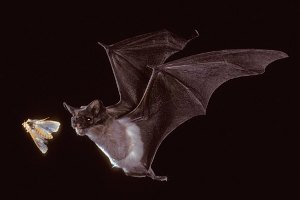Listen to the QUEST radio story A California Bat Success Story
This colony of bats is a local success story, says Dave Johnston, a biologist with the Western Bat Working Group, a collection of government agencies and non-profit groups from 13 states.
Johnston says this bridge was originally built about 50 years ago. Like most bridges, it went into disrepair, he says. “They knew they had to replace the causeway and the bridge.”
But that meant displacing one of the biggest bat colonies in Northern California. The county brought in wildlife biologists who came up with a design for bat houses, perched on stilts near the river.
But the bats didn’t like their bat houses, so, the biologists tried something simpler. Five redwood beams, fixed to the underside of the bridge. It worked.
Just two months later, says Johnston, the population went from about 2,000 in the area to 15,600.
The story got a lot of news coverage, in part, because it’s such a stark contrast to what’s going on back east.
In 2006, scientists in New York state discovered that a strange new disease was wiping out entire colonies of bats. White-nose syndrome, as it’s now known, is caused by a fungus that destroys the bats’ skin and eventually kills them.
Now, white-nose syndrome is heading west.
Johnston believes white-nose syndrome will inevitably be introduced into California, probably by some unknowing visitor who has it on his or her shoes and clothes.
And once that happens, several species of bats in California are likely to get sick. The most vulnerable are the little brown bats living in the far north and the Sierra Nevada Mountains. Those bats hibernate in caves, where the fungus thrives.
But in warmer parts of the state, like the Bay Area and Central valley, bats don’t hibernate, which means they might not fall prey to white-nose syndrome.
One way of keeping close tabs on California’s bats is by listening to them. That’s a specialty of Winston Lancaster, a biologist at California State University, Sacramento.
To listen to bats, Lancaster uses what’s called a bat detector, which is about the size and shape of an old transistor radio. It can detect sounds that are too high frequency, and too fast for humans to hear, then convert and slow them so they’re audible to human ears.
For scientists keeping track of bats, listening to them is one of the best ways to know how the animals are doing. That’s because bats use sound to navigate, and to eat. You can hear those echolocation calls clearly in these bat detector recordings made by Winston Lancaster.
[jwplayer config=”QUEST Audio Player” skin=”http://ww2.kqed.org/quest/wp-content/themes/quest/glow.zip” file=”http://www.kqed.org/.stream/anon/quest/batsounds.mp3″ ]
Listen to bat detector recordings made by Winston Lancaster.
“There’s a search phase of echolocation,” says Lancaster, in which the animal is just flying and making a sound, looking for insects in its area.”
But as the bat approaches its prey, the sounds get faster and faster, until they reach what Lancaster calls “the terminal phase.”
“They’re essentially going as fast as they possibly can. So when you hear all this, you know that the animal has made an attempt to feed.”
From an economic perspective, feeding is exactly what makes these bats so important. During the summer, a lactating female bat may eat as much as her own body weight’s worth of insects, every single night.
Johnston says bats are some of the unsung heroes of California’s agricultural economy.
Bat advocates are calling for strong federal action to try and stop the spread of white-nose syndrome. They say by limiting human access to caves and other places bats hibernate, white-nose syndrome can be stopped, or at least slowed down.
This story is based on reporting by QUEST TV producer Gabriela Quirós. Tune in to Bats in Our Midst later this spring.
38.2546373 -121.2999485
 A Mexican free-tailed bat hunts a corn earworm moth.
A Mexican free-tailed bat hunts a corn earworm moth. 